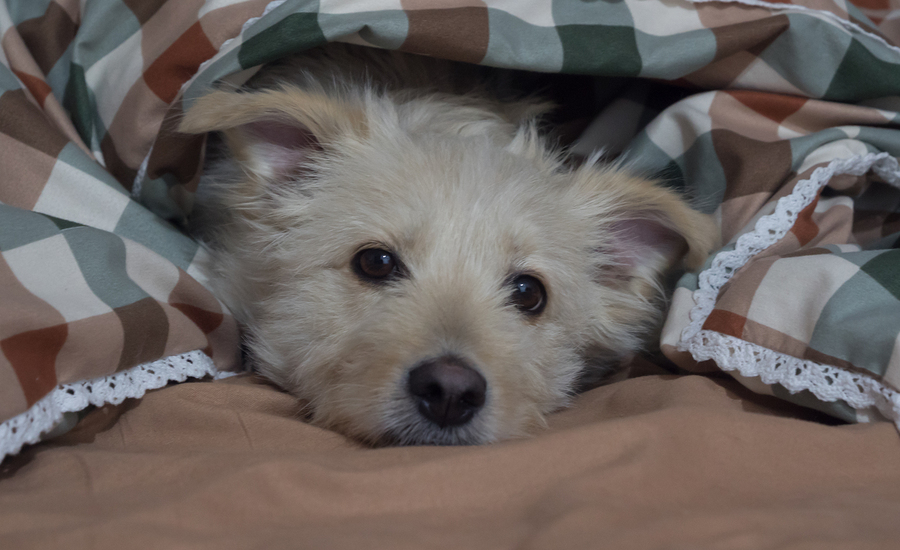Is it noise aversion?
Does your dog run and hide or start panting and shaking when children in the neighborhood set off firecrackers? Has your dog run away during the Fourth of July celebration? If so, your dog likely suffers from noise aversion, also commonly known as noise anxiety or noise phobia. Noise aversion affects two-thirds1 of dog in the U.S. In fact, shelters report that July 5 is the day that they have the highest number of intakes due to dogs running away during firework displays.2 Other common signs of noise aversion include barking and whining, excessively seeking attention from the owner, cowering, and hypervigilance. Even lip licking and yawning are signs that your dog is stressed.
Noise aversion is not just something that dogs experience as a reaction to fireworks, but to many other noises including thunder, construction, celebration, sporting events, traffic noises, etc. Often dogs who have noise aversion to fireworks also react to some of these other noises.
Is noise aversion a medical condition?
Did you know that noise aversion indicates that your dog is anxious and fearful of these noises and is a serious medical condition? This is because what your dog is experiencing when she or he reacts to the noise is similar to what a person experiences when they have a panic attack.
Noise aversion not only affects your dog; it might also have a negative impact on your relationship with your dog, either due to repeatedly having to repair property your dog damaged trying to escape or visits to the veterinarian because your dog hurt himself trying to escape. Additionally, the worry and concern for the dog’s quality of life or loss of sleep can ultimately lead to a fracture in the human-animal bond.
What do I do?
The good news is your veterinarian has many options to help address your dog’s noise aversion. Therefore, it is important for you to tell your veterinarian how your dog reacts to the noises associated with the Fourth of July well before the holiday. Preparation is key for reducing the fear, anxiety and stress for your pet during this time.
What are some of your options? The first is to minimize your dog’s exposure to the sound of fireworks.You can pull the shades and play music or white noise. You can also create a safe haven for your dog. If your dog runs to the bathroom, into a closet, or heads for the basement at the first “boom,” you can put a bed in their preferred location and amp it up by feeding them treats or putting your dog’s toys in that area to train them to associate a positive experience with that place. Other techniques, called behavior modification, can be used to teach your dog how to better tolerate fireworks; your veterinarian can provide you with this information or may refer you to a veterinary behaviorist or certified trainer.
There are also medications that can help. One option is Sileo (dexmedetomidine oromucosal gel), the first FDA-approved treatment for canine noise aversion. Sileo can be given 30-60 minutes before the noise event or at the time you first hear the noise, or when your dog begins to show signs of noise aversion. Sileo calms your dog without sedation, so that he or she can enjoy the holiday with the family. There are other medications that may also help your dog. Once you discuss your dog’s noise aversion with your veterinarian, she will be able to determine what treatment options are best for your dog.
So before the Fourth comes around again, take this quiz to see if your dog suffers from noise aversion. Then bring it to your veterinarian to begin the conversation and start the treatment that will help improve your dog’s quality of life, and as a result, yours as well.
IMPORTANT SAFETY INFORMATION
Do not use SILEO in dogs with severe cardiovascular disease, respiratory, liver or kidney diseases, or in conditions of shock, severe debilitation, or stress due to extreme heat, cold. or fatigue or in dogs hypersensitive to dexmedetomidine or to any of the excipients. SILEO should not be administered in the presence of preexisting hypotension, hypoxia, or bradycardia. Do not use in dogs sedated from previous dosing. SILEO has not been evaluated in dogs younger than 16 weeks of age or in dogs with dental or gingival disease that could have an effect on the absorption of SILEO. SILEO has not been evaluated for use in breeding, pregnant, or lactating dogs or for aversion behaviors to thunderstorms. Transient pale mucous membranes at the site of application may occur with SILEO use. Other uncommon adverse reactions included emesis, drowsiness or sedation. Handlers should avoid direct exposure of SILEO to their skin, eyes or mouth. Failure to lock the ring-stop on the syringe before dosing SILEO could potentially lead to an accidental overdose. Always review INSTRUCTIONS FOR USE before dispensing and dosing. See full Prescribing Information.
This article was reviewed/edited by board-certified veterinary behaviorist Dr. Kenneth Martin and/or veterinary technician specialist in behavior Debbie Martin, LVT.

This article is brought to you in collaboration with our friends at Zoetis Petcare. SIL-00387
References
-
- The Harris Poll: Custom Motion Sickness and Noise Aversion Omnibus Pet Owner Quantitative Research Report, December 2018
- Hanson, H. Scary Reason Why Shelters Get So Busy on the Fourth. Huffington Post. July 1, 2017 Retrieved March 22, 2019 from: https://www.huffpost.com/entry/fourth-of-july-animal-shelters-busy-pet-safety_n_5956a9d6e4b0da2c732379a6








